Sanmac® 2205 is a machinability-improved version of the duplex (austenitic-ferritic) stainless steel SAF 2205™. The grade is characterized by:
- High resistance to stress corrosion cracking (SCC) in chloride-bearing environments
- High resistance to stress corrosion cracking (SCC) in environments containing hydrogen sulphide
- High resistance to general corrosion, pitting and crevice corrosion
- High mechanical strength – roughly twice the proof strength of austenitic stainless steels
- Excellent machinability
- Good hot working properties
- High resistance to erosion corrosion and corrosion fatigue
- Physical properties that offer design advantages
- Good weldability
Standards
- UNS: S31803, S32205
- EN Number: 1.4462
- W.Nr.: 1.4462
- DIN: X 2 CrNiMoN 22 5 3
Product standards
EN 10088-3
Suitable for the production of flanges etc. according to ASTM A-182 Grade F51/F60
Analysis according to ASTM A-479, UNS S31803/S32205.
Certificates
Status according to EN 10204/3.1
Chemical composition (nominal) %
| C | Si | Mn | P | S | Cr | Ni | Mo | N |
|---|---|---|---|---|---|---|---|---|
| ≤0.030 | ≤1.0 | ≤2.0 | ≤0.030 | ≤0.015 | 22.5 | 5.5 | 3.2 | 0.18 |
Applications
Due to its excellent corrosion properties, Sanmac® 2205 is a highly suitable material for service in environments containing chlorides and hydrogen sulphide. The steel is also suitable for use in dilute sulphuric acid solutions and for handling organic acids, such as acetic acid and mixtures.
The high strength of Sanmac® 2205 makes the material an attractive alternative to the austenitic steels in structures subjected to heavy loads.
The good mechanical and corrosion properties make Sanmac® 2205 an economical choice in many applications, by reducing the life cycle cost of equipment.
The good machining properties make Sanmac® 2205 a superior alternative to standard SAF 2205™ and other duplex grades, for applications subjected to all types of machining, by extending tool life and creating opportunities for increased productivity.
| Industrial categories | Typical applications |
|---|---|
| Chemical industry | Flanges |
| Refineries | Valves |
| Petrochemical industry | Fittings |
| Oil & gas industry | Couplings |
| Rings | |
| Shafts | |
| Forgings | |
| Discs |
Corrosion resistance
General corrosion
In most media, Sanmac® 2205 possesses better resistance to general corrosion than steel types ASTM 316L and 317L. Impurities that increase corrosivity are often present in acid process solutions. If there is a risk of active corrosion, higher alloyed austenitic stainless steels should be chosen, e.g. Alleima 2RK65™ or Sanicro® 28.
Pitting and crevice corrosion
The pitting and crevice corrosion resistance of a steel is determined primarily by its chromium and molybdenum contents, but also by its nitrogen content, inclusion composition and inclusion content. A parameter for comparing the resistance of different steels to pitting is the PRE number (Pitting Resistance Equivalent).
The PRE is defined as, in weight -%: PRE = % Cr + 3.3 x % Mo +16 x % N
The PRE numbers for Sanmac® 2205 and other materials are given in the following table.
| Alloy | % Cr | % Mo | % N | PRE |
|---|---|---|---|---|
| Sanmac 2205 | 22 | 3.2 | 0.18 | >35 |
| Alloy 825 | 21.5 | 3.0 | - | 31 |
| ASTM 317L | 18 | 3.5 | - | 30 |
| ASTM 316L | 17 | 2.2 | - | 24 |
The ranking given by the PRE number has been confirmed in laboratory tests. This ranking can generally be used to predict the performance of an alloy in chloride-containing environments. Laboratory determinations of critical temperature, for initiation of pitting (CPT) at different chloride contents are shown in fig. 4. The testing conditions chosen have yielded results that agree well with practical experience. Thus, Sanmac® 2205 can be used at considerably higher temperatures and chloride contents than ASTM 304 and ASTM 316, without pitting occurring. Sanmac® 2205 is, therefore, far more serviceable in chloride-bearing environments than standard austenitic steels.
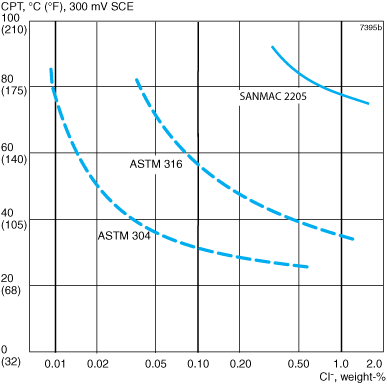 Figure 4. Critical pitting temperatures (CPT) for Sanmac SAF 2205, AISI 304 and AISI 316 at varying concentrations of sodium chloride (potentiostatic determination at +300 mV SCE), pH 6.0.*
Figure 4. Critical pitting temperatures (CPT) for Sanmac SAF 2205, AISI 304 and AISI 316 at varying concentrations of sodium chloride (potentiostatic determination at +300 mV SCE), pH 6.0.*
Stress corrosion cracking
The standard austenitic steels of the ASTM 304L and ASTM 316L types are prone to stress corrosion cracking (SCC) in chloride-bearing solutions at temperatures above 60°C (140°F). Duplex stainless steels are far less prone to this type of corrosion. Laboratory tests have shown the good resistance to stress corrosion cracking of Sanmac® 2205. Results from these tests are presented in fig. 5. The diagram indicates the temperature-chloride range, within which Sanmac® 2205 and the standard steels ASTM 304L and ASTM 316L can be used without risk of stress corrosion cracking.
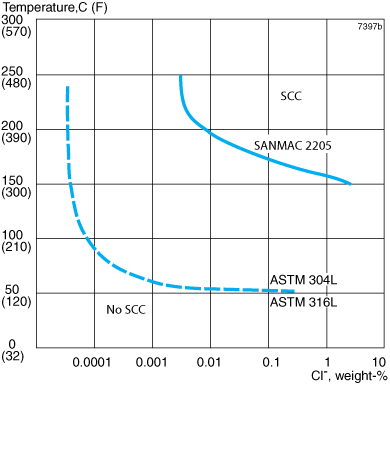
Intergranular corrosion
Sanmac® 2205 is a member of the family of modern duplex stainless steels, whose chemical composition is balanced in such a way that the reformation of austenite in the heat affected zone, adjacent to the weld, takes place quickly. This results in a microstructure that gives corrosion properties and toughness roughly equal to that of the parent metal. Therefore, Sanmac® 2205 easily passes intergranular corrosion testing, according to ASTM A262 Practice E (Strauss' test).
Erosion corrosion
Steels of the ASTM 316 type are attacked by erosion corrosion if exposed to flowing media containing highly abrasive solid particles, e.g. sand, or to media with very high flow velocities. Because of its combination of high hardness and good corrosion resistance, Sanmac® 2205 displays very good resistance under such conditions.
Corrosion fatigue
Sanmac® 2205 possesses higher strength and better corrosion resistance than ordinary austenitic stainless steels. It, therefore, also possesses better fatigue strength under corrosive conditions than such steels.
* The information in the graphs above originate from the material datasheet for SAF 2205™ seamless tube and pipe. For further information regarding corrosion resistance of Sanmac® 2205 please refer to this datasheet. The data should be considered in the knowledge that it may not be applicable for thick sections such as forgings.
Forms of supply
Sizes and tolerances
Round-cornered square, as well as round billets, are produced in a wide range of sizes according to the following tables. Larger sizes offered on request.
Surface conditions
Square billets
Unground, spot ground or fully ground condition.
Round billets
Peel turned or black condition.
| Size | Tolerance | Length |
|---|---|---|
| mm | mm | m |
| 80 | +/-2 | 4 - 6.3 |
| 100, 114, 126, 140, 150 | +/-3 | 4 - 6.3 |
| 160, 180, 195, 200 | +/-4 | 4 - 6.3 |
| >200 - 350 | +/-5 | 3 - 5.3 |
Sizes and tolerances apply to the rolled/forged condition.
| Size | Tolerance | Length |
|---|---|---|
| mm | mm | m |
| 75 - 200 (5 mm interval) | +/-1 | max 10 |
| >200 - 450 | +/-3 | 3 - 8 |
| Size | Tolerance | Length |
|---|---|---|
| mm | mm | m |
| 77 - 112 (5 mm interval) | +/-2 | max 10 |
| 124, 134 | +/-2 | max 10 |
| 127, 147, 157 | +/-2 | max 10 |
| 142, 152, 163 | +/-2 | max 10 |
| 168, 178, 188 | +/-2 | max 10 |
| 183, 193 | +/-2 | max 10 |
Other product forms for SAF 2205™ and Sanmac® 2205:
- Bar and hollow bar (Sanmac®)
- Seamless tube and pipe
- Welded tube and pipe
- Fittings and flanges
Heat treatment
Sanmac® 2205 billets are normally delivered in the hot worked and air cooled condition, but can be solution annealed and quenched when required. If additional heat treatment is needed after further processing, the following is recommended:
Solution annealing at 1020 – 1100°C (1870 – 2010°F), followed by quenching in water.
Stress relief heat treatment at 350°C (660 oF) for 5h followed by air cooling
Mechanical properties
Testing is performed on separately solution annealed and quenched test pieces. The following figures apply to material in the solution annealed and quenched condition.
At 20°C (68°F)
| Proof strength | Tensile strength | Elong. |
Hardness Brinell
|
|
|---|---|---|---|---|
| Rp0.2a) | Rp1.0a) | Rm | Ab) | |
| MPa | MPa | MPa | % | |
| ≥450 | ≥500 | 660-860 | ≥25 |
≤270
|
| Proof strength | Tensile strength | Elong. |
Hardness Brinell
|
|
|---|---|---|---|---|
| Rp0.2a) | Rp1.0a) | Rm | Ab) | |
| ksi | ksi | ksi | % | |
| ≥65 | ≥73 | 96-125 | ≥25 |
≤270
|
1 MPa = 1 N/mm 2
a) Rp0.2 and Rp1.0 correspond to 0.2% offset and 1.0% offset yield strengths, respectively.
b) Based on L0 = 5.65√S0, where L0 is the original gauge length and S0 the original cross-sectional area.
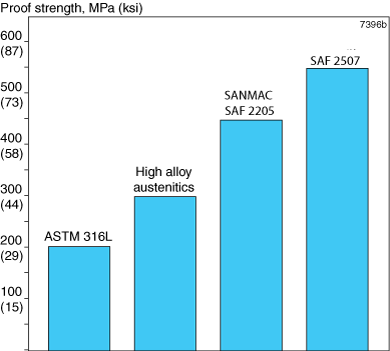
Impact strength
Sanmac® SAF 2205 possesses good impact strength both at room temperature and at low temperatures. Figure 2 shows typical impact energy values for Sanmac®SAF 2205 bar steel, in different sizes, at -50°C (-58°F), using standard Charpy V specimens. Samples are taken in the longitudinal direction for sizes up to 160 mm. For sizes over 160mm the transversal direction applies. The impact energy ( Charpy V) at 20° ( 68°F) is, 100 J ( 74 ft-lb) min.
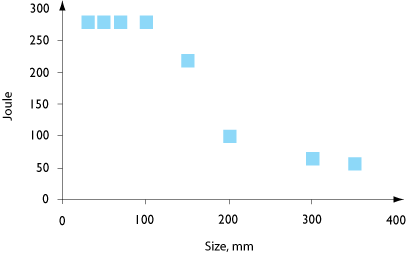 Figure 2. Typical impact energy values at -50°C (-58°F), for Sanmac 2205 bar steel.
Figure 2. Typical impact energy values at -50°C (-58°F), for Sanmac 2205 bar steel.
| Temp. | Proof Strength | Temp. | Proof Strength |
|---|---|---|---|
| Rp0.2 | Rp0.2 | ||
| °C | MPa | °F | ksi |
| min. | min. | ||
| 100 | 360 | 200 | 52 |
| 150 | 335 | 300 | 49 |
| 200 | 315 | 400 | 46 |
| 250 | 300 | 500 | 44 |
If Sanmac® 2205 is exposed to temperatures exceeding 280°C (540°F) for prolonged periods, the microstructure changes, which results in a reduction in impact strength. This effect may alter the behavior of the material at the operating temperature. Contact us for more information.
Physical properties
| At 20°C (68°F), typical values | |
|---|---|
| Density | 7.8 g/cm3 , 0.28 lb/in3 |
| Modulus of elasticity | 200x103 MPa, 29x103 ksi |
| Specific heat capacity | 480 J/kg °C, 0.11 Btu/ lb °F |
| Thermal conductivity | 14 W/m °C, 8 Btu/ft h°F |
| Thermal expansion at 30-100°C (86-212°F) | 13 x10-6/°C, 7.0 x10-6/°F |
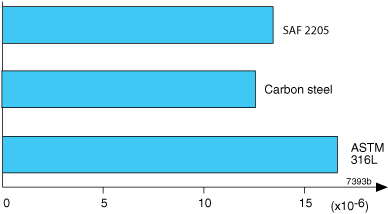
Figure 3. Thermal expansion, per °C (30-100°C (85- 210 oF).)
Sanmac® 2205 has a far lower coefficient of thermal expansion than austenitic stainless steels and can, therefore, possess certain design advantages.
Hot working
Sanmac® 2205 is ductile at higher temperatures. The deformation resistance increases with decreasing temperatures, and hot working should, therefore, be carried out at a material temperature of 975-1200°C (1790-2190°F). If the temperature falls below 950°C during hot working there is a risk of sigma phase formation, and the material must therefore be reheated. Hot working of Sanmac® 2205 should be followed by solution annealing and quenching, in accordance with the recommendations given for heat treatment.
Microstructure
In the solution annealed and quenched condition, Sanmac® 2205 has an austenitic-ferritic microstructure and the ferrite content is 40 – 60%.
Welding
The weldability of SANMAC® 2205 is good. Suitable methods of fusion welding are manual metal-arc welding (MMA/SMAW) and gas-shielded arc welding, with the TIG/GTAW method as first choice.
Since this material is alloyed in such a way to improve machinability, the amount of surface oxides on the welded beads might be higher compared to standard 2205 steel. This may lead to arc instability during TIG/GTAW welding, especially welding without filer material. However, the welding behavior of this material is the same as for standard 2205 steel when welding with filler material.
For SANMAC® 2205, heat input of 0.5-2.5 kJ/mm and interpass temperature of <150°C (300°F) are recommended. Preheating and post-weld heat treatment are normally not necessary.
Recommended filler metals
TIG/GTAW or MIG/GMAW welding
ISO 14343 S 22 9 3 N L / AWS A5.9 ER2209 (e.g. Exaton 22.8.3.L)
MMA/SMAW welding
ISO 3581 E 22 9 3 N L R / AWS A5.4 E2209-17 (e.g. Exaton 22.9.3.LR)
ISO 3581 E 22 9 3 N L B / AWS A5.4 E2209-15 (e.g. Exaton 22.9.3.LB)
Machining
General
Sanmac stands for Alleima Machinability Concept. In Sanmac® materials, machinability has been improved without jeopardizing properties, such as corrosion resistance and mechanical strength.
Improved machinability is brought about by:
- Optimized non-metallic inclusions
- Optimum chemical composition
- Optimized process and production parameters
Detailed recommendations for the choice of tools and cutting data, for turning, thread cutting, parting/grooving, drilling, milling and sawing, are provided in the brochure S-029-ENG.
Machining chart
The diagram shows the ranges, within which data should be chosen in order to obtain a tool life of 10 minutes minimum when machining the duplex Sanmac® 2205. The ranges are limited in the event of low feeds, because of unacceptable chip breaking. In the case of high cutting speeds, plastic deformation is the most dominant cause of failure. When feed increases and the cutting speed falls, edge frittering (chipping) increases significantly.
The diagram is applicable for short cutting times. For long continuous cuts, cutting speeds should be reduced.
 Figure 6. Machining chart for Sanmac SAF 2205.
Figure 6. Machining chart for Sanmac SAF 2205.
The lowest recommended cutting speed is determined by the tendency of the material to stick to the insert (built-up edge), although the integrity of insert clamping and the stability of the machine are also of great significance.
It is important to conclude, which wear mechanism is active, in order to optimize cutting data with the aid of the diagram.
Turning Sanmac® 2205
Recommended insert and cutting data (starting values)
| Insert Geometry | Grade | Cutting data Feed | Cutting speed |
Application
|
|---|---|---|---|---|
| mm/rev. | m/min | |||
| MF | GC2015 | 0.15 | 180 |
Finishing, copy turning
|
| MM | GC2025 | 0.30 | 120 |
Medium-to-rough machining under less stable conditions
|
Drilling Sanmac® 2205
The recommended methods for drilling give the most cost effective results for the respective diameter ranges. When producing holes with diameters larger than 58 mm, short hole drilling is used up to 58 mm, followed by internal turning, up to the desired diameter. Cutting data for internal turning should be chosen in accordance with the turning recommendations. The recommendations for drilling are applicable for a tool life of 30 minutes.
Short hole drilling, diameter 12.7 - 58 mm
Coromant U-drill, R416.2
| Insert Geometry | Grade | Cutting data, Feed | Cutting speed |
|---|---|---|---|
| mm/rev. | m/min | ||
| -53 | Central insert GC1020 |
- | - |
| -53 | Peripheral insert GC1020* |
0,04-0,18 | 100 |
* GC1120 for diameters below 17.5 mm
Drilling with Alleima Coromant Delta C drill, diameter 3 - 12.7 mm
Code R415.5. Grade GC1220
(diameter range 3 - 20 mm)
| Cutting data, Feed* | Cutting speed |
|---|---|
| mm/rev. | m/min |
| 0.08-0.22 | 40 |
* The lower feed value should be selected for smaller diameters
Drilling with high speed steel (HSS) drill
(diameter 1-3 mm)
| Cutting data, Feed* | Cutting speed** |
|---|---|
| mm/rev. | m/min |
| 0.03-0.09 | 6-12 |
* The lower feed value should be selected for smaller diameters
** The higher cutting speed should be selected for coated drills
Milling Sanmac® SAF 2205
Use of optimum cutting data means that milling can be carried out at cutting speeds above those where there is a risk of built-up edge formation. Dry milling results in long tool life. If coolant is needed (e.g. when the surface cannot be reached in the dry condition), the cutting speed must be reduced by approximately 40-60% to prevent tool wear due to increased thermal load on the inserts.
Milling with CoroMill cutters (starting values for dry machining)
| Roughing Geometry/Grade | Cutting speed | Finishing Geometry/Grade | Cutting speed |
|---|---|---|---|
| m/min | m/min | ||
| MM-2030 | 110 | ML-2030 | 150 |
Threading Sanmac® 2205
Indexable inserts can be used for external thread cutting of all diameters. Threading with screw-cutting dies or die heads is economical only for small diameters. For internal threading with short and normal cutting lengths, thread cutting with indexable inserts is recommended above a hole diameter of 12 mm. For long cutting lengths, thread cutting with indexable inserts is recommended for hole diameters above 20 mm.
Thread turning
Due to the tendency of duplex materials to work harden, radial infeed is recommended. A generous flow of cutting fluid should also be used, partly to obtain a reliable process and partly to guide the chip. The recommendations apply to a tool life of 30 minutes.
| Insert Geometry |
Grade | Cutting speed m/min |
|---|---|---|
| F | GC1020 | 120 |
Thread tapping
Compared with uncoated threading taps, coated threading taps can improve productivity by up to 100%. For the advantages of coated threading taps to be realized, a generous flow of cooling fluid must be used. The recommendations apply to a tool life of 30 minutes.
| Cutting speed m/min |
|---|
| 4-10 |
The higher range of cutting data should be chosen for coated threading taps
Sawing Sanmac® 2205
Cutting with bandsaws or cold saws gives the best cutting economy. If the demand for surface smoothness is great, circular sawing is preferable. Band sawing gives high productivity, is flexible and incurs low investment costs.
When band sawing Sanmac® 2205, the Sandflex Cobra type 3851 bimetallic bandsaw blades, which is available from Bahco Group (formerly Sandvik Saws and Tools), is recommended.
Tooth spacing should be selected according to the dimensions of the material to be cut, and stated in TPI (the number of teeth per in.). The TPI should be reduced for thicker dimensions. For a bar dimension of D = 150 mm, 2/3 TPI or 1/2 TPI is recommended.
| Cutting speed m/min |
|---|
| 25-35 |
Feed is regulated to obtain a good chip form.
Disclaimer: Recommendations are for guidance only, and the suitability of a material for a specific application can be confirmed only when we know the actual service conditions. Continuous development may necessitate changes in technical data without notice. This datasheet is only valid for Alleima materials.